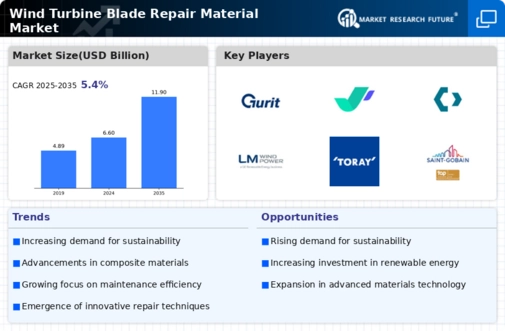Market Growth Projections
The Global Wind Turbine Blade Repair Material Market Industry is poised for substantial growth, with projections indicating a market value of 6.6 USD Billion in 2024 and an anticipated increase to 11.9 USD Billion by 2035. This growth trajectory reflects a compound annual growth rate (CAGR) of 5.48% from 2025 to 2035. Such figures underscore the increasing importance of repair materials in maintaining the operational efficiency of wind turbines. The market dynamics suggest a robust demand for innovative and sustainable repair solutions as the global wind energy sector continues to expand.
Regulatory Support and Incentives
Government policies and incentives play a crucial role in shaping the Global Wind Turbine Blade Repair Material Market Industry. Many countries are implementing favorable regulations to promote the use of renewable energy, which indirectly boosts the demand for repair materials. For example, tax credits and subsidies for wind energy projects encourage investments in maintenance and repair solutions. This regulatory support is expected to contribute to the market's growth, with projections indicating a market value of 11.9 USD Billion by 2035. Such initiatives not only enhance the sustainability of wind energy but also create a conducive environment for the repair material sector.
Increasing Focus on Sustainability
The Global Wind Turbine Blade Repair Material Market Industry is increasingly influenced by the global focus on sustainability. As environmental concerns rise, there is a growing need for eco-friendly repair materials that minimize environmental impact. Manufacturers are responding by developing bio-based resins and recyclable composites, which align with sustainability goals. This shift towards greener materials is likely to attract investments and drive innovation within the sector. The emphasis on sustainability is expected to bolster market growth, as stakeholders seek solutions that not only repair but also contribute to a more sustainable energy future.
Growing Demand for Renewable Energy
The Global Wind Turbine Blade Repair Material Market Industry is experiencing a surge in demand driven by the increasing global emphasis on renewable energy sources. As countries strive to meet their carbon reduction targets, wind energy has emerged as a pivotal component of the energy mix. The International Energy Agency indicates that wind power capacity is expected to double by 2030, necessitating robust repair solutions for turbine blades. This growth translates to a projected market value of 6.6 USD Billion in 2024, highlighting the critical need for effective repair materials to ensure operational efficiency and longevity of wind turbines.
Rising Operational Costs of Wind Farms
The Global Wind Turbine Blade Repair Material Market Industry is also driven by the rising operational costs associated with wind farms. As the number of installed wind turbines increases, so does the need for regular maintenance and repair to ensure optimal performance. High operational costs can significantly impact the profitability of wind energy projects, prompting operators to invest in effective repair materials. This trend is likely to sustain the market's growth trajectory, as stakeholders prioritize cost-effective solutions that enhance the reliability and efficiency of wind turbines.
Technological Advancements in Repair Techniques
Innovations in repair techniques are significantly influencing the Global Wind Turbine Blade Repair Material Market Industry. Advanced materials such as carbon fiber composites and epoxy resins are being developed to enhance the durability and performance of turbine blades. These materials not only extend the lifespan of blades but also reduce maintenance costs. For instance, the introduction of automated repair systems has streamlined the repair process, making it more efficient. As a result, the market is projected to grow at a CAGR of 5.48% from 2025 to 2035, reflecting the increasing adoption of these advanced repair technologies.




















Leave a Comment